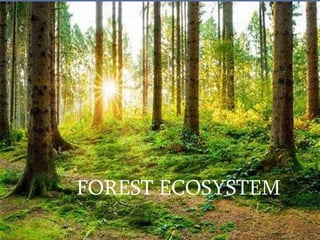The Forest Ecosystem and its Classification
•Descargar como PPTX, PDF•
0 recomendaciones•22 vistas
The forest ecosystem
Denunciar
Compartir
Denunciar
Compartir

Recomendados
Más contenido relacionado
Similar a The Forest Ecosystem and its Classification
Similar a The Forest Ecosystem and its Classification (20)
Natural vegetation and wildlife PPT for class 9 CBSE

Natural vegetation and wildlife PPT for class 9 CBSE
Salient features of grassland, forest and desert ecosystem

Salient features of grassland, forest and desert ecosystem
Último
Xanthomonas axonopodis pv.citri is a bacterium that attacks citrus trees and flourishes in locations with high temperatures, rains and strong winds. In places with these features, X. axonopodis pv.citri produces citrus canker, resulting in significant economic losses for citrus companies. It spreads by the unintentional movement of diseased citrus fruits and seedlings to uninfected areas.Virulence Analysis of Citrus canker caused by Xanthomonas axonopodis pv. citr...

Virulence Analysis of Citrus canker caused by Xanthomonas axonopodis pv. citr...TALAPATI ARUNA CHENNA VYDYANAD
Último (20)
mixotrophy in cyanobacteria: a dual nutritional strategy

mixotrophy in cyanobacteria: a dual nutritional strategy
WASP-69b’s Escaping Envelope Is Confined to a Tail Extending at Least 7 Rp

WASP-69b’s Escaping Envelope Is Confined to a Tail Extending at Least 7 Rp
Film Coated Tablet and Film Coating raw materials.pdf

Film Coated Tablet and Film Coating raw materials.pdf
Constraints on Neutrino Natal Kicks from Black-Hole Binary VFTS 243

Constraints on Neutrino Natal Kicks from Black-Hole Binary VFTS 243
Plasmapheresis - Dr. E. Muralinath - Kalyan . C.pptx

Plasmapheresis - Dr. E. Muralinath - Kalyan . C.pptx
GBSN - Microbiology (Unit 7) Microbiology in Everyday Life

GBSN - Microbiology (Unit 7) Microbiology in Everyday Life
GBSN - Microbiology Lab (Microbiology Lab Safety Procedures)

GBSN - Microbiology Lab (Microbiology Lab Safety Procedures)
Continuum emission from within the plunging region of black hole discs

Continuum emission from within the plunging region of black hole discs
Virulence Analysis of Citrus canker caused by Xanthomonas axonopodis pv. citr...

Virulence Analysis of Citrus canker caused by Xanthomonas axonopodis pv. citr...
The Scientific names of some important families of Industrial plants .pdf

The Scientific names of some important families of Industrial plants .pdf
Manganese‐RichSandstonesasanIndicatorofAncientOxic LakeWaterConditionsinGale...

Manganese‐RichSandstonesasanIndicatorofAncientOxic LakeWaterConditionsinGale...
Factor Causing low production and physiology of mamary Gland

Factor Causing low production and physiology of mamary Gland
SaffronCrocusGenomicsThessalonikiOnlineMay2024TalkOnline.pptx

SaffronCrocusGenomicsThessalonikiOnlineMay2024TalkOnline.pptx
The Forest Ecosystem and its Classification
- 2. FOREST is typically a large area covered mainly with trees and undergrowth. Forests cover one third of the earth's land mass, performing vital functions and supporting the livelihoods of 1.6 billion people. Forests are home to more than half of the world’s land-based species of animals, plants and insects. They also combat climate change and buffer the impacts of storms and floods.
- 3. A forest ecosystem is a natural habitat for plants and animals in a woodland area. It consists of all the living (biotic) and non- living (abiotic) components of the environment that interact with each other. All living (biotic) components can be divided into Producer, Consumer and Decomposer.
- 4. Plants are the primary producers in a forest ecosystem. Producers make their own food. Plants do this through the process of photosynthesis. Many producers also happen to produce, or make, things that animals eat.
- 6. Emergent Layer- This layer is composed of tall trees (70-80 meters max) and is reported to obtain constant sunlight. They’re found only in tropical forests. Forest Canopy- Trees are closely spaced and can be anywhere from 10-25 meters high, but can also be as high as 60 meters. Animals including monkeys, birds, insects, and reptiles inhabit the canopy. Understory- It refers to the plants present just beneath the canopy, and hence, is dimply lit. The majority of the trees are smaller ones (5-10 meters).
- 7. Shrub Layer- The shrub layer is 1-5 meters. They’re rarely found in tropical forests. Some deciduous temperate forests have a rich shrub layer. Non-Woody Herbaceous Ground Cover- In tropical forests, this strata is rarely more than 10% of the forest area. Its mainly just plants and some grasses. Moss, Cryptogam, and Shallow Soil Layer- It includes fallen logs of trees and decomposing litter of fallen leaves and twigs.
- 9. All animals, including mammals, others are called Consumers. Consumers rely on plants and other animals as a food source. Primary Consumers only eat plants and are referred to as Herbivores. Secondary Consumers are referred to as carnivores and feed on Herbivores. Tertiary Consumers is an animal that obtains its nutrition by eating primary and secondary consumers. Omnivores eat both plants and animals.
- 11. Decomposers are any organisms that lives off of ingesting other dead organisms. Decomposers break down dead plants and animals, returning the nutrients to the soil to be made usable by the producers. These include bacteria, ants, termites, earthworms, fungi, etc.